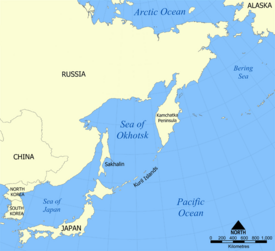Northeast Asia

Northeast Asia or Northeastern Asia is a geographical subregion of Asia. Its northeastern landmass and islands are bounded by the North Pacific Ocean.
The term Northeast Asia was popularized during the 1930s by American historian and political scientist Robert Kerner. Under Kerner's definition, "Northeast Asia" includes the Japanese Archipelago, the Korean Peninsula, the Mongolian Plateau, the Northeast China Plain, and the mountainous regions of the Russian Far East, stretching from the Lena River in the west to the Pacific Ocean in the east.[1]
Definitions
The definition of Northeast Asia is not static but often changes according to the context in which it is discussed.
The subregion of Northeast Asia comprises China, Japan, and Korea, usually also including Mongolia and Siberia. Parts or the whole of northern China are also frequently included in sources.[2][3][4] The Economic Research Institute for Northeast Asia defines the region as China, Japan, Korea, Mongolia, and Russia.[5]
Prominent cities in this area include Busan, Changchun, Dalian, Harbin, Hiroshima, Incheon, Khabarovsk, Kitakyushu, Kobe, Kyoto, Nagasaki, Nagoya, Osaka, Pyongyang, Sapporo, Seoul, Shenyang, Tokyo, Ulaanbaatar, Vladivostok, and Yokohama.
Economy

Northeast Asia is one of the most important economic regions of the world, accounting for 25.3% of the world's nominal GDP in 2019, which is slightly larger than the United States. It is also one of the major political centers and has significant influence on international relations. By the end of the 1990s, Northeast Asia had a share of 12% of the global energy consumption, with a strong increasing trend. By 2030, the major economic growth in the region is expected to double or triple this share.
Biogeography
In biogeography, Northeast Asia generally refers roughly to the area spanning the Japanese Archipelago, the Korean Peninsula, Northeast China, and the Russian Far East between Lake Baikal in southern Siberia and the Pacific Ocean.
Northeast Asia is mainly covered by temperate forest, taiga, and the Eurasian Steppe, while tundra is found in the region's far north. Summer and winter temperatures are highly contrasted. It is also a mountainous area.
See also
- Amur River
- Arctic shipping routes
- Bering Strait
- East Asia
- Far East
- Inner Mongolia
- Kamchatka
- Korean Peninsula
- Lake Baikal
- Manchuria
- North Asia
- Northeast China
- Russian Far East
- Russian studies
- Sea of Japan
- Sea of Okhotsk
- Siberia
References
Citations
- ^ Narangoa 2014, p. 2.
- ^ "Northeast Asia dominates patent filing growth." Retrieved on August 8, 2001.
- ^ Schott, Jeffrey J.; Goodrich, Ben. "Economic Integration in Northeast Asia" (PDF). Peterson Institute for International Economics. Archived from the original (PDF) on 2016-03-04. Retrieved August 8, 2011.
- ^ Gilbet Rozman (2004), Northeast asia's stunted regionalism: bilateral distrust in the shadow of globalization. Cambridge University Press, pp. 3–4
- ^ Economic Research Institute for Northeast Asia (1999). Japan and Russia in Northeast Asia: Partners in the 21st Century. Greenwood Publishing Group. p. 248.
Sources
- Narangoa, Li (2014). Historical Atlas of Northeast Asia, 1590-2010: Korea, Manchuria, Mongolia, Eastern Siberia. New York, NY: Columbia University Press. ISBN 9780231160704.
External links
- Center for Northeast Asian Policy Studies—Brookings Institution
- Kimura, Takeatsu – International Collation of Traditional and Folk Medicine - Northeast Asia - UNESCO
